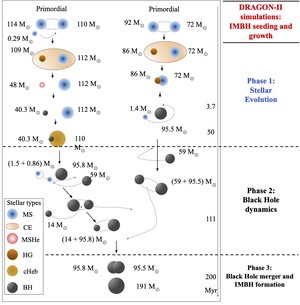
Fig. 1
The elusive intermediate-mass black holes (IMBHs) may represent the missing link between stellar mass and the gargantuan supermassive black holes inhabiting galactic nuclei. The formation and growth ofsuch objects represent a fascinating mystery of modern astronomy, mostly owing to the lack of a definitive smoking gun supporting the very existence of IMBHs. In a new suite of high-resolution numerical simulations, called the DRAGON-II cluster database, an international team of astronomers, lead by Manuel Arca Sedda have found that IMBHs can form in young, dense, and massive star clusters. Mirosław Giersz from the Copernicus Center in Warsaw is a member of the team.
The formation process goes via a complex combination of mergers among massive stars, interactions among stars and stellar BHs, and BH-BH coalescence events (Figs.1 and 2). These unprecedented simulations feature a large number of stars (up to 1 million) and binary fraction (10-30%) filling the gap between direct N-body and Monte Carlo simulations. Simulated clusters resemble clusters observed in the Milky Way, the Magellanic clouds, and other galaxies in the local Universe. “Teenage” IMBHs formed via such complex phenomena undergo a turbulent phase during which strong interactions with other stars and stellar BHs can lead to the ejection of the IMBH from the parent cluster after over a relatively short timescale, of the order of up to a few hundred Myr, thus preventing its further growth. Our models show that while IMBH seeds form naturally from energetic stellar interactions in star clusters, they are unlikely to grow heavier than a few hundred solar masses, unless the parent cluster is extremely dense or massive.
Attached two figures explain how IMBHs form in discussed simulations. Please note that the simulations utilise up to 1 million stars with 33% of them initially paired in a binary. These are record-breaking features never achieved in this field, and finally permit to bridge the so-called N-body simulations, highly accurate but computationally demanding, and Monte Carlo models, less accurate but computationally convenient. Running such simulations was practically impossible until a few years ago, thus authors want to highlight such computational challenge alongside the astrophysical challenge of understanding how (or if) IMBHs form.

Fig.2
Detailed results and discussion in papers:
see also a movie:






